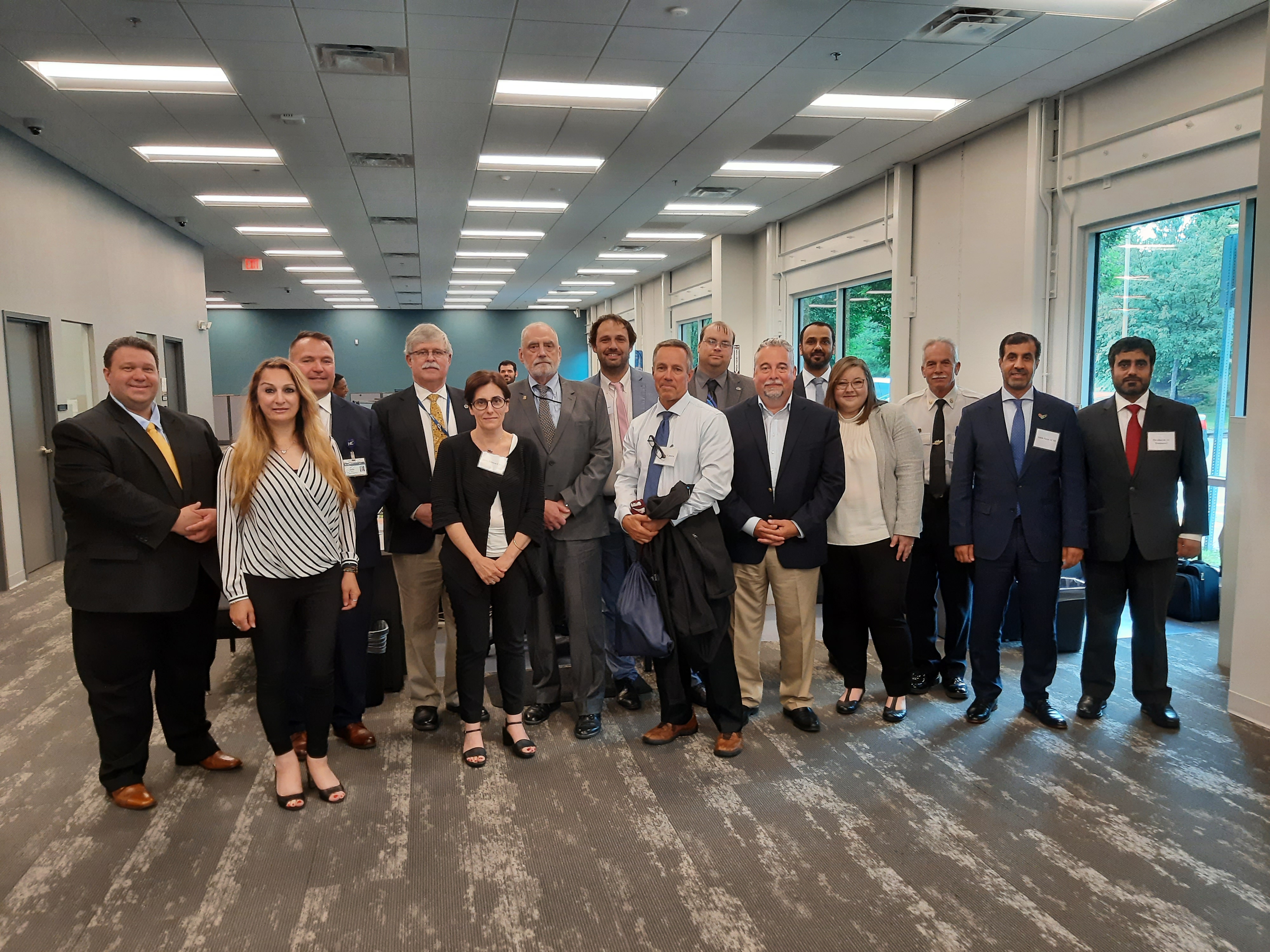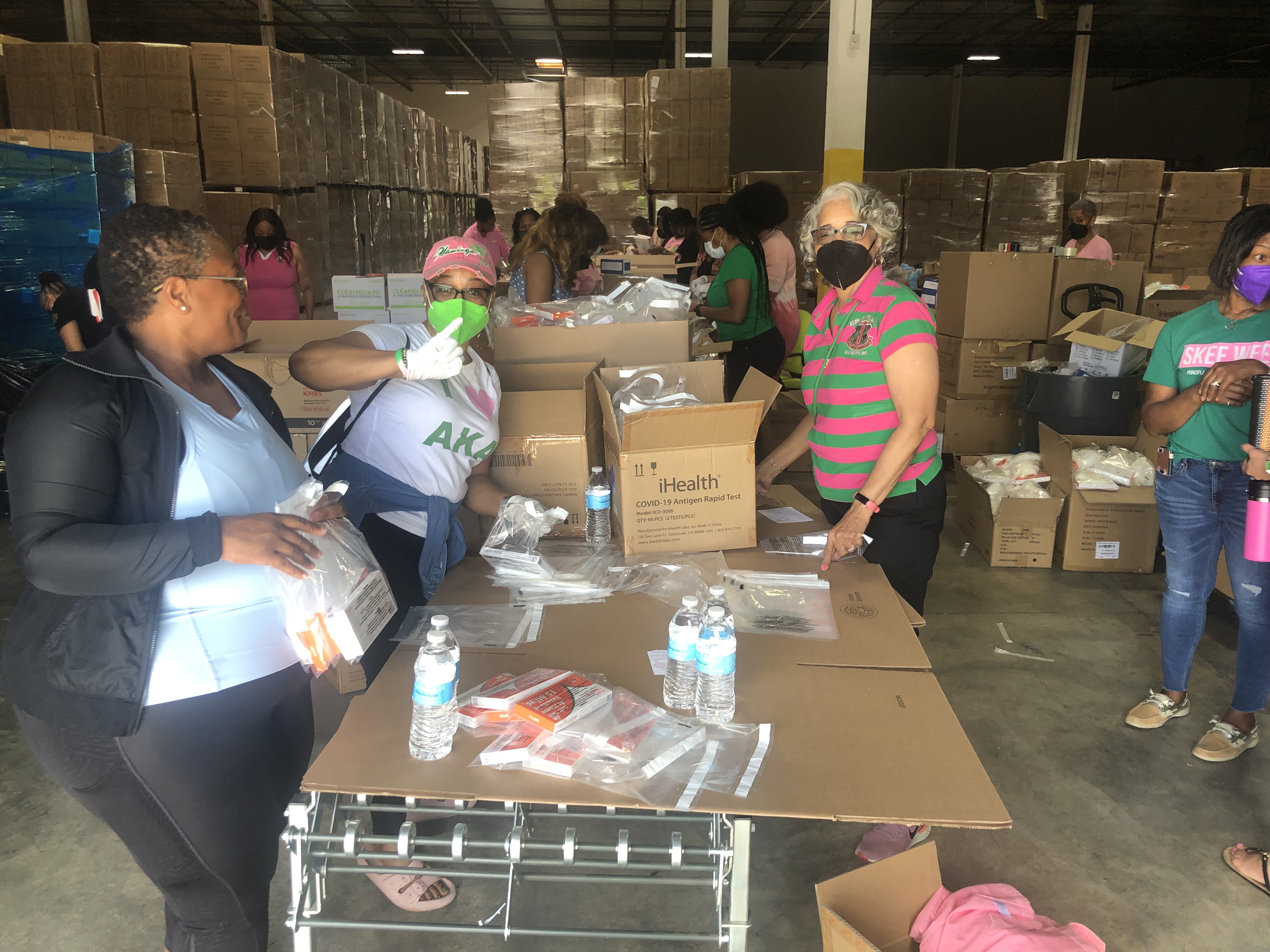2021-2022
OP&R Hosts International Delegation to Discuss Disaster Preparedness (June 2022)

OP&R, along with the Maryland Department of Emergency Management (MDEM) and other state partners, hosted a visiting delegation of health professionals from France and the United Arab Emirates on June 23rd to discuss solutions for operations centers and incident management and to exchange ideas on disaster preparedness. They also looked for opportunities to collaborate both domestically and internationally in the future. After meeting at the OP&R offices, the group traveled to Johns Hopkins Hospital to tour their Operations Command Center (below).

AKAs Assist OP&R to Pack PPE Kits (May 2022)
On Saturday, May 28th, OP&R Acting Deputy Director Nicole Brown and a group of her sorority sisters from the Epsilon Omega Chapter of Alpha Kappa Alpha Sorority, Inc. came to the OP&R Warehouse to help package approximately 4,000 Personal Protective Equipment (PPE) kits.
These kits included gloves, masks and test kits and are part of a regional project that will be distributed to Baltimore County Public Schools graduating seniors to help mitigate the risk of COVID-19 infection. Thank you AKAs for doing your part to help create a more prepared Maryland!

Governor Larry Hogan stopped by one of OP&R's warehouse facilities on May 10th 2022 to announce the the shipment of a multimillion dollar aid package to support the people of Odesa, Ukraine, a sister city of Baltimore. Some of the supplies sent include 485,000 bandages and wound care supplies, 95 Eternity mechanical ventilators for hospital intensive care units, and 50 Astral portable ventilators. Other items shipped included nearly 200 pieces of body armor, consisting of tactical vests and shields, which were donated by the Maryland State Police.
Read more about the press conference here.
 Governor Hogan poses with the OP&R staff after announcing that Maryland will be sending more life-saving medical supplies to Ukraine.
Governor Hogan poses with the OP&R staff after announcing that Maryland will be sending more life-saving medical supplies to Ukraine.
OP&R Director Sherry Adams Reitres from Public Service (October 2021)

Congratulations to Sherry Adams, beloved Director of the Maryland Office of Preparedness and Response on her well deserved retirement from public service! The OP&R staff threw a huge surprise retirement party for Sherry on October 29th that was attended by Maryland Department of Health (MDH) leadership, former staff, friends, family and many more partners that Sherry has worked with over the years. She even received a special award from Governor Hogan (above) to recognize her many years of faithful service to the citizens of Maryland. It was presented to her by Secretary of Health Dennis Schrader (above left), and former Secretary Robert Neall (above right). Other senior staff in attendance included MDH Deputy Secretary of Operations Atif Chaudhry and Deputy Secretary for Public Health Dr. Jinlene Chan (below).
 Sherry also received a letter of appreciation (below) for her many years of public health service from the Office of the Assistant Secretary of Preparedness and Response (ASPR) which was presented by members of the U.S. Department of Health and Human Services (HHS).
Sherry also received a letter of appreciation (below) for her many years of public health service from the Office of the Assistant Secretary of Preparedness and Response (ASPR) which was presented by members of the U.S. Department of Health and Human Services (HHS).

The team from HHS even gave Sherry a replica of the U.S. flag (below) that was flown in her honor above the U.S. Capitol in Washington on the day of her retirement on November 1st. She later received the actual flag that flew. This is a true testament to the impact that Sherry has had on public health, not just here in Maryland, but across the country as well.

Just as important as the many accolades that Director Adams has achieved, is the amazing respect, dedication and love that Sherry has shown to every person who worked with her at OP&R over the past 13 years. All of our staff, past and present, as well as our many partners wish Sherry nothing but the best in her well-deserved retirement. We love you so much and thank you for all that you have done for us and the citizens of our great state.
OP&R Reaches the One Year Mark of Their COVID-19 Pandemic Response (January 2021)
The Office of Preparedness and Response hit a big milestone on January 18th, 2021 as that day marked exactly one year since the start of their response to the COVID-19 pandemic. Since that day, OP&R has been in full emergency response mode, helping to manage all aspects of the state's COVID-19 response including daily planning and coordination of the Maryland COVID-19 Vaccination Plan.
Reaching the one anniversary is by no means a reason to celebrate, as thousands of Maryland lives have been lost during that time, but OP&R is very proud of its resilience and contributions during the past year. Here are some thoughts from members of the staff as they reflect on what it means to reach the one year mark of OP&R's COVID-19 response.
Sherry Adams, Director of OP&R: "The entire team here at OP&R has made considerable contributions to the mission to stop COVID-19 in Maryland. We have made it through some really tough times over the past year, and still have a ways to go, but I am so proud of what we have done. Everyone here has sacrificed so much and given up so much time with their families for the sake of the mission."
Veronica Black, Deputy Director of OP&R: "This has been one tough year! However, our team has demonstrated a level of resiliency that is truly commendable. We continue to stand Maryland Strong, Maryland Ready to Respond!"
Nicole S. Brown, Healthcare Preparedness Program Manager: "It's been a long year and I have learned so much along the way. Most importantly, I have learned that with teamwork, any task can be accomplished!"
Bernadette Eichman, Healthcare Preparedness Program Planner: "Reaching the one year mark of responding to COVID-19 calls for a moment of reflection on how far we've come. From the knowledge, skills and lessons learned to the partnerships enriched; this response has demonstrated the dedication of colleagues and partners to help Marylanders."
Peter Fotang, Epidemiologist, Biosurveillance Program: "While it was always known that OP&R is one of the most important arms in the state's readiness to respond, this pandemic has reinforced that. Our office has risen to the occasion at every turn, with all staff supporting each other from the very start ."
Dr. Al Romanosky, Medical Director at OP&R: "As the great Robert Frost once said, 'In three words, I can sum up everything I've learned about life: IT GOES ON.' And that's exactly the way we've tackled the pandemic here at OP&R. We've manned up and kept it moving!"
2019-2020
Since the start of the pandemic, the Office of Preparedness and Response has been in full emergency response mode, helping to manage all aspects of the COVID-19 response in Maryland. One of the most critical aspects of OP&R's responsibilities is the planning and coordination of the Maryland COVID-19 Vaccination Plan. In conjunction with other Maryland Department of Health staff members and agencies, OP&R helped to design this extensive vaccination plan. A draft copy was finally submitted to the Centers for Disease Control on October 16, 2020. Read a draft copy of the plan here.
Since then, the entire staff of OP&R has spent countless hours in daily planning meetings with countless other federal agencies, MDH officials, doctors, vaccine experts, MD State Police, hospitals and local health departments from every county in Maryland. Their goal is to make sure the COVID-19 vaccines are delivered, properly stored and distributed so that every citizen in Maryland will have a chance to be vaccinated.
On December 14th, the first shipments of vaccine finally arrived at University of Maryland Medical Center. Although there is still a long way to go, this momentous occasion gave us all a ray of hope in this nearly year-long battle to stop the spread of COVID-19. Thanks to the entire OP&R staff for their tireless service to this cause, along with all of our great partners across the state. There is still a long road in front of us, but if we continue to work together, we can prevail over this deadly disease!
Election Day may have been a day off for most Maryland state employees, but for the staff at OP&R, it was a "day on" as part of a statewide effort to monitor voting activities for any incidents or events that may affect public health. In conjunction with other state agencies including the Maryland Emergency Management Agency (MEMA), the OP&R team was part of the Incident Command System (ICS) that worked together to ensure the health and safety of all voters and poll workers across the state.
On that same day, hundreds of
Maryland Responds Medical Reserve Corps volunteers signed up to be Health Ambassadors. In cooperation with the
Maryland State Board of Elections, these volunteers were assigned to polling places in multiple jurisdictions throughout the state to help keep voters and poll workers protected from COVID-19 and other infectious diseases.
2017-2018

